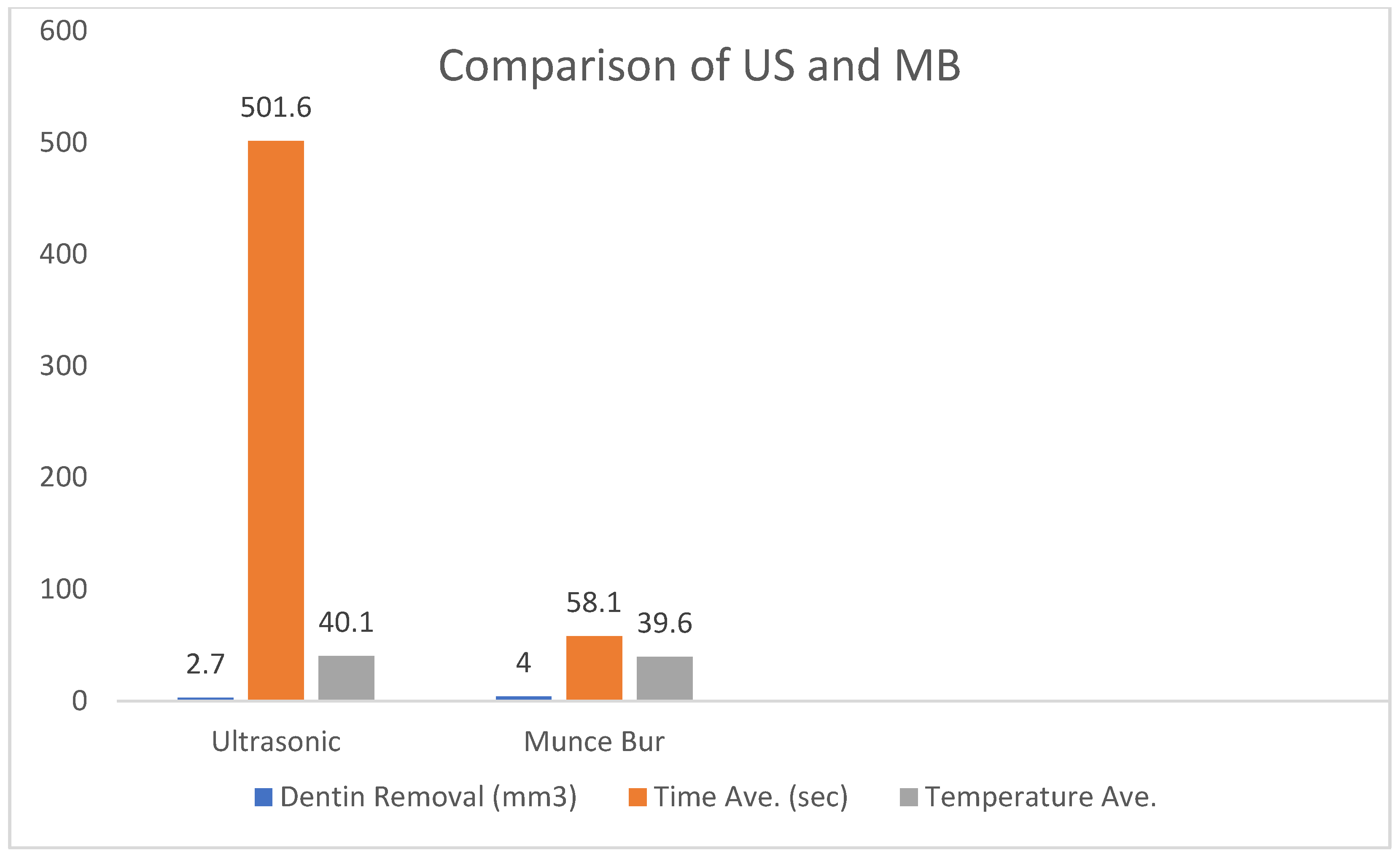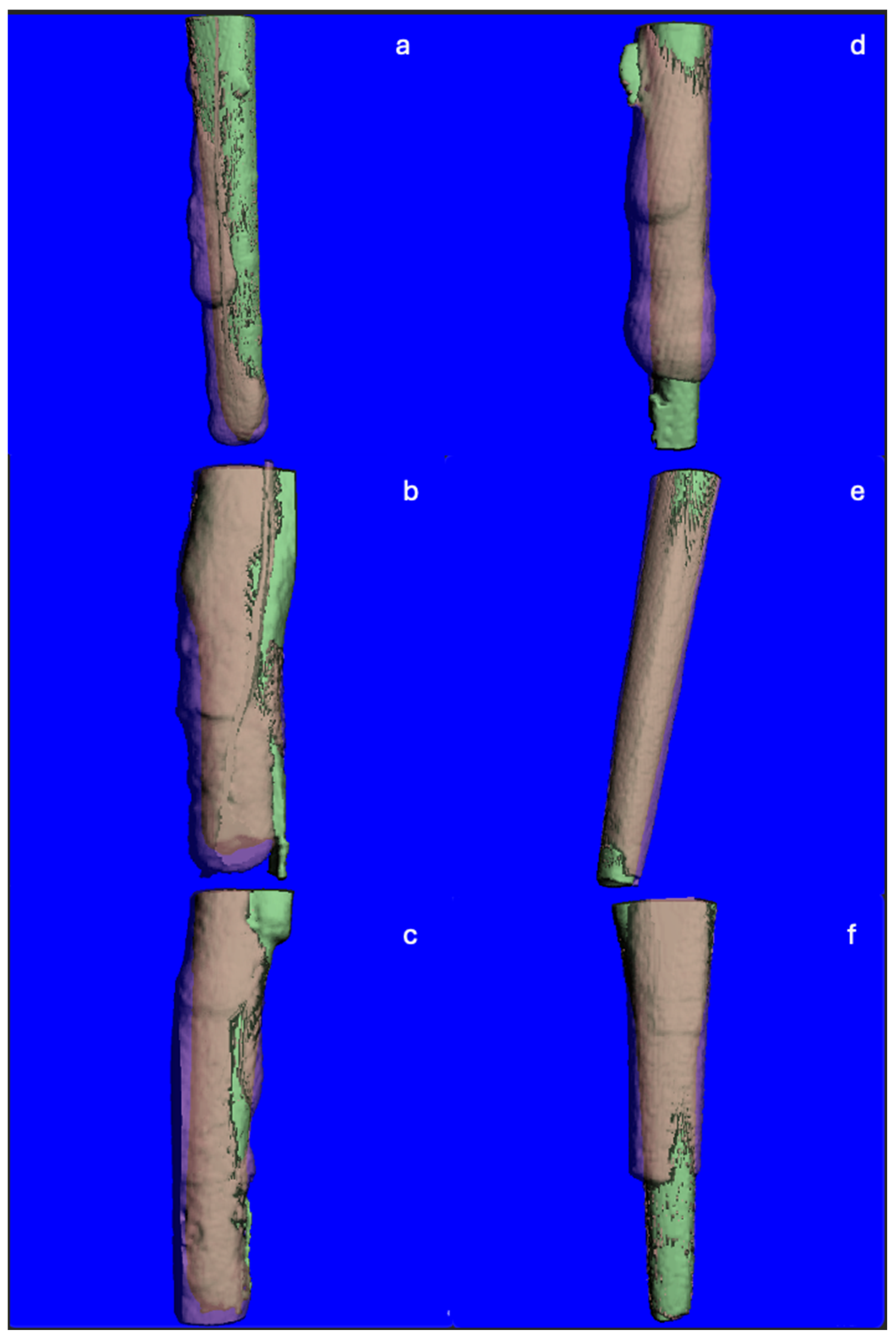Comparison of Two Fiber Post Removal Techniques Evaluating Dentin Removal, Efficiency, and Heat Production
Abstract
1. Introduction
2. Materials and Methods
2.1. Selection
2.2. Preparation of Samples
2.3. Initial Micro-CT Scan
2.4. Post Placement and Removal
2.5. Follow-Up Micro-CT Scan
2.6. Statistical Analysis
3. Results
3.1. Dentin Removal
3.2. Efficiency
3.3. Temperature Change
4. Discussion
5. Conclusions
Author Contributions
Funding
Institutional Review Board Statement
Informed Consent Statement
Data Availability Statement
Acknowledgments
Conflicts of Interest
References
- Grossman, L.I. Endodontic treatment. Arq. Cent. Estud. Fac. Odontol. UFMG 1968, 5, 47–52. [Google Scholar] [PubMed]
- Turner, C.H. The retention of dental posts. J. Dent. 1982, 10, 154–165. [Google Scholar] [CrossRef] [PubMed]
- Christensen, G.J. Posts: Necessary or Unnecessary? J. Am. Dent. Assoc. 1996, 127, 1522–1524, 1526. [Google Scholar] [CrossRef] [PubMed]
- Wang, X.; Shu, X.; Zhang, Y.; Yang, B.; Jian, Y.; Zhao, K. Evaluation of FPs vs metal posts for restoring severely damaged endodontically treated teeth: A systematic review and meta-analysis. Quintessence Int. 2019, 50, 8–20. [Google Scholar] [CrossRef] [PubMed]
- Alshabib, A.; Abid Althaqafi, K.; AlMoharib, H.S.; Mirah, M.; AlFawaz, Y.F.; Algamaiah, H. Dental Fiber-Post Systems: An In-Depth Review of Their Evolution, Current Practice and Future Directions. Bioengineering 2023, 10, 551. [Google Scholar] [CrossRef] [PubMed] [PubMed Central]
- Lamichhane, A.; Xu, C.; Zhang, F.Q. Dental fiber-post resin base material: A review. J. Adv. Prosthodont. 2014, 6, 60–65. [Google Scholar] [CrossRef] [PubMed] [PubMed Central]
- Nakajima, M.; Kanno, T.; Komada, W.; Miura, H.; Foxton, R.M.; Tagami, J. Effect of bonded area and/or FP placement on the fracture strengths of resin-core reconstructions for pulpless teeth. Am. J. Dent. 2010, 23, 300–304. [Google Scholar] [PubMed]
- Duret, B.; Reynaud, M.; Duret, F. Un nouveau concept de reconstitution corono-radiculaire: Le Composipost (1) [New concept of coronoradicular reconstruction: The Composipost (1)]. Chir. Dent. Fr. 1990, 60, 131–141. [Google Scholar] [PubMed]
- Nair, P.N.; Henry, S.; Cano, V.; Vera, J. Microbial status of apical root canal system of human mandibular first molars with primary apical periodontitis after “one-visit” endodontic treatment. Oral Surg. Oral Med. Oral Pathol. Oral Radiol. Endod. 2005, 99, 231–252. [Google Scholar] [CrossRef] [PubMed]
- Crump, M.C. Differential diagnosis in endodontic failure. Dent. Clin. N. Am. 1979, 23, 617–635. [Google Scholar] [CrossRef] [PubMed]
- Tamse, A.; Fuss, Z.; Lustig, J.; Kaplavi, J. An evaluation of endodontically treated vertically fractured teeth. J. Endod. 1999, 25, 506–508. [Google Scholar] [CrossRef] [PubMed]
- Ossareh, A.; Rosentritt, M.; Kishen, A. Biomechanical studies on the effect of iatrogenic dentin removal on vertical root fractures. J. Conserv. Dent. 2018, 21, 290–296. [Google Scholar] [CrossRef] [PubMed] [PubMed Central]
- Rainwater, A.; Jeansonne, B.G.; Sarkar, N. Effects of ultrasonic root-end preparation on microcrack formation and leakage. J. Endod. 2000, 26, 72–75. [Google Scholar] [CrossRef] [PubMed]
- Garrido, A.D.; Fonseca, T.S.; Alfredo, E.; Silva-Sousa, Y.T.; Sousa-Neto, M.D. Influence of ultrasound, with and without water spray cooling, on removal of posts cemented with resin or zinc phosphate cements. J. Endod. 2004, 30, 173–176. [Google Scholar] [CrossRef] [PubMed][Green Version]
- Dominici, J.T.; Clark, S.; Scheetz, J.; Eleazer, P.D. Analysis of heat generation using ultrasonic vibration for post removal. J. Endod. 2005, 31, 301–303. [Google Scholar] [CrossRef] [PubMed][Green Version]
- Scotti, N.; Bergantin, E.; Alovisi, M.; Pasqualini, D.; Berutti, E. Evaluation of a simplified FP removal system. J. Endod. 2013, 39, 1431–1434. [Google Scholar] [CrossRef] [PubMed]
- Rollings, S.; Stevenson, B.; Ricketts, D. Posts–when it all goes wrong! Part 2: Post removal techniques. Dent. Update 2013, 40, 166–178. [Google Scholar] [CrossRef] [PubMed]
- Purger, L.O.; Tavares, S.J.; Martinez, R.L.; Caldas, I.; Antunes, L.A.; Scelza, M.Z. Comparing Techniques for Removing Fiber Endodontic Posts: A Systematic Review. J. Contemp. Dent. Pract. 2021, 22, 587–595. [Google Scholar] [PubMed]
- Alsafra, S.; Yassin, O.; Mohammad, Y. Effect of three glass fiber post removal techniques on the amount of removed root dentin An in vitro study. Saudi Endod. J. 2021, 11, 240–245. [Google Scholar] [CrossRef]
- Plotino, G.; Pameijer, C.H.; Grande, N.M.; Somma, F. Ultrasonics in endodontics: A review of the literature. J. Endod. 2007, 33, 81–95. [Google Scholar] [CrossRef] [PubMed]
- Arukaslan, G.; Aydemir, S. Comparison of the efficacies of two different fiber post-removal systems: A micro-computed tomography study. Microsc. Res. Tech. 2019, 82, 394–401. [Google Scholar] [CrossRef] [PubMed]
- Eriksson, A.R.; Albrektsson, T. Temperature threshold levels for heat-induced bone tissue injury: A vital-microscopic study in the rabbit. J. Prosthet. Dent. 1983, 50, 101–107. [Google Scholar] [CrossRef] [PubMed]
- Farah, R.I. Effect of cooling water temperature on the temperature changes in pulp chamber and at handpiece head during high-speed tooth preparation. Restor. Dent. Endod. 2018, 44, e3. [Google Scholar] [CrossRef] [PubMed] [PubMed Central]
- Alfadda, A.; Alfadley, A.; Jamleh, A. Fiber Post Removal Using a Conservative Fully Guided Approach: A Dental Technique. Case Rep. Dent. 2022, 2022, 3752466. [Google Scholar] [CrossRef] [PubMed] [PubMed Central]
- Xue, Y.; Zhang, L.; Cao, Y.; Zhou, Y.; Xie, Q.; Xu, X. A three-dimensional printed assembled sleeveless guide system for fiber-post removal. J. Prosthodont. 2023, 32, 178–184. [Google Scholar] [CrossRef] [PubMed]
- Janabi, A.; Tordik, P.A.; Griffin, I.L.; Mostoufi, B.; Price, J.B.; Chand, P.; Martinho, F.C. Accuracy and Efficiency of 3-dimensional Dynamic Navigation System for Removal of Fiber Post from Root Canal-Treated Teeth. J. Endod. 2021, 47, 1453–1460. [Google Scholar] [CrossRef] [PubMed]
- CDC. Guidelines for Infection Control in Dental Health-Care Settings—2003. MMWR 2003, 52, 1–66. Available online: https://www.cdc.gov/mmwr/preview/mmwrhtml/rr5217a1.htm (accessed on 22 February 2023).
- Mattison, G.D.; Delivanis, P.D.; Thacker, R.W., Jr.; Hassell, K.J. Effect of post preparation on the apical seal. J. Prosthet. Dent. 1984, 51, 785–789. [Google Scholar] [CrossRef] [PubMed]
- McLean, A. Criteria for the predictably restorable endodontically treated tooth. J. Can. Dent. Assoc. 1998, 64, 652–656. [Google Scholar] [PubMed]
- Juloski, J.; Radovic, I.; Goracci, C.; Vulicevic, Z.R.; Ferrari, M. Ferrule effect: A literature review. J. Endod. 2012, 38, 11–19. [Google Scholar] [CrossRef] [PubMed]
- Chen, J.; Yue, L.; Wang, J.D.; Gao, X.J. The correlation between the enlargement of root canal diameter and the fracture strength and the stress distribution of root. Zhonghua Kou Qiang Yi Xue Za Zhi 2006, 41, 661–663. (In Chinese) [Google Scholar] [PubMed]
- Haupt, F.; Riggers, I.; Konietschke, F.; Rödig, T. Effectiveness of different fiber post removal techniques and their influence on dentinal microcrack formation. Clin. Oral. Investig. 2022, 26, 3679–3685. [Google Scholar] [CrossRef] [PubMed] [PubMed Central]
- Krug, R.; Schwarz, F.; Dullin, C.; Leontiev, W.; Connert, T.; Krastl, G.; Haupt, F. Removal of fiber posts using conventional versus guided endodontics: A comparative study of dentin loss and complications. Clin. Oral Investig. 2024, 28, 192. [Google Scholar] [CrossRef] [PubMed] [PubMed Central]
- Davis, S.; Gluskin, A.H.; Livingood, P.M.; Chambers, D.W. Analysis of temperature rise and the use of coolants in the dissipation of ultrasonic heat buildup during post removal. J. Endod. 2010, 36, 1892–1896. [Google Scholar] [CrossRef] [PubMed]
- Honda, R.; Pelepenko, L.E.; Monteiro, M.F.; Marciano, M.A.; Gomes, B.P.F.A.; de Jesus Soares, A.; Ferraz, C.R.; Almeida, J.F.A. Fibre post removal using ultrasonic tips: A comparative in vitro study using different protocols. Aust. Endod. J. 2025, 51, 47–54. [Google Scholar] [CrossRef] [PubMed]



| Munce Bur | Ultrasonic | p Value | |
|---|---|---|---|
| Dentin Removal | |||
| Average pre-operative canal volume (mm3) | 11.1 | 12.6 | 0.248 |
| Average post-operative volume (mm3) | 15.1 | 15.3 | |
| Efficiency | |||
| Average time for post removal (s) | 58.1 | 501.6 | <0.001 |
| Minimum time for removal (s) | 31 | 182 | |
| Maximum time for removal (s) | 150 | 951 | |
| Temperature Change | |||
| Group Maximum Temperature (°C) | 42.9 | 42.7 | 0.60 |
| Average Maximum Temperature (°C) | 39.6 | 40.1 |
Disclaimer/Publisher’s Note: The statements, opinions and data contained in all publications are solely those of the individual author(s) and contributor(s) and not of MDPI and/or the editor(s). MDPI and/or the editor(s) disclaim responsibility for any injury to people or property resulting from any ideas, methods, instructions or products referred to in the content. |
© 2025 by the authors. Licensee MDPI, Basel, Switzerland. This article is an open access article distributed under the terms and conditions of the Creative Commons Attribution (CC BY) license (https://creativecommons.org/licenses/by/4.0/).
Share and Cite
Fenigstein, M.; Askar, M.; Maalhagh-Fard, A.; Paurazas, S. Comparison of Two Fiber Post Removal Techniques Evaluating Dentin Removal, Efficiency, and Heat Production. Dent. J. 2025, 13, 234. https://doi.org/10.3390/dj13060234
Fenigstein M, Askar M, Maalhagh-Fard A, Paurazas S. Comparison of Two Fiber Post Removal Techniques Evaluating Dentin Removal, Efficiency, and Heat Production. Dentistry Journal. 2025; 13(6):234. https://doi.org/10.3390/dj13060234
Chicago/Turabian StyleFenigstein, Matthew, Mazin Askar, Ahmad Maalhagh-Fard, and Susan Paurazas. 2025. "Comparison of Two Fiber Post Removal Techniques Evaluating Dentin Removal, Efficiency, and Heat Production" Dentistry Journal 13, no. 6: 234. https://doi.org/10.3390/dj13060234
APA StyleFenigstein, M., Askar, M., Maalhagh-Fard, A., & Paurazas, S. (2025). Comparison of Two Fiber Post Removal Techniques Evaluating Dentin Removal, Efficiency, and Heat Production. Dentistry Journal, 13(6), 234. https://doi.org/10.3390/dj13060234








